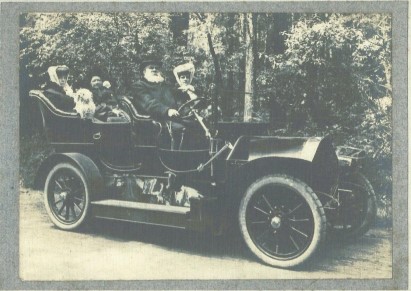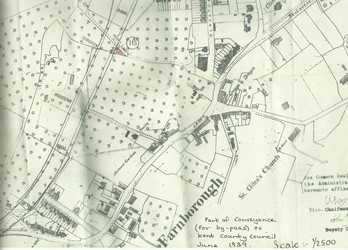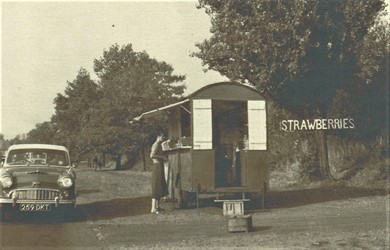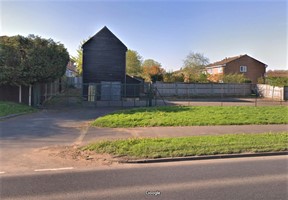


THE PLUMBRIDGES
The story begins with Edward Plumbridge (1838-1917) who had a chain of fruit shops in London especially at train stations. In those days strawberries were at least 24 hours old by the time they were sold in London. Edward thought if people could only taste fresh strawberries they would no longer want the older ones (amusing today). In 1874 he bought a piece of land twelve miles from the City in Farnborough, bordering the High Street. He sent his second son William (1866-1912) down to manage it.
Edward had one of the first cars in the neighbourhood (1897) with a chauffeur. Each weekday he would be taken to Bromley South Station to catch the London train and oversee his business commitments. Nett used to maintain this car along with his own motor bike. One day Nett was repairing the car and his father William, who had never driven a car, said “Let me drive it up to Dad and surprise him!” He couldn’t control it, cried “Whoa, whoa” and mowed down a row of poplar trees, thereby damaging the car all over again!
 |
 |
| Edward Plumbridge with his family | |
William died young, aged 46, when Nett was only 20 and the farm was then run by Nett on behalf of one of his uncles although he later inherited it in his own right. He always called it “the grounds” due to its original description as fruit grounds. At that time it had fruit, vegetables, chickens, turkeys and pigs. Also there were two cart horses called Nobby and Rufus.
Nett worked closely with Edward and learned a lot about the Plumbridge family history through him. When Edward was young he was very friendly with the boy who grew up to be Sir Henry Irving, the famous Victorian actor. In later years, Edward and his wife, Louisa, were invited to all his first night performances in London.
Nett went to Dulwich College and one day in about 1908, jumping onto his homebound train at the last minute, he shared a carriage with Andrew Carnegie, who had come to open the library in Bromley which he had funded. Nett told his granddaughter, Celia, the story of Will Scrivens who worked on the farm many years ago. Apparently he worked like clockwork and could plant 1,000 cabbages an hour! In 1916 Nett married Florence Coleby (1892-1984) and Eric (1918- 1997) was born a few years later. They lived in Wellclose, the house (belonging to Nett’s mother’s family) on Farnborough Common near where the laundry used to be. This house was demolished in 2017.
Farnborough Bypass
 |
|
| This is the conveyancing map dated 1939. But the OS map used shows the line of Farnborough bypass before it was built, so the underlying map is from before 1926. |
In both wars farming was ,of course, a reserved occupation so neither Eric or Nett were in the forces. During the Second World War an air raid shelter was built on the farm under a great hill of excavated earth. As the farm was near Biggin Hill airfield, Eric could see the battle of Britain going on in the air above him. The shelter was later found to be useful for storing apples as it was very cold down there!
In 1945 Eric married Barbara Munday (1921-2015) and Celia was born in 1949. There were also two boys, but unfortunately they were too premature to survive in the 1950s. Before their daughter’s birth they moved into Branksome Cottage which was a family house next to Fleetwood and is also no longer standing. Celia remembers playing down at the farm and mid- morning sandwiches with everyone sat in a circle in the barn, which can still be seen on the Farnborough by-pass.
 |
 |
| The Barn | Selling fruit and vegetables 1960s |
There were now no more pigs or horses. She recalls Nett and Eric busy in the fields and Flo helping in “the wagon” - the fruit and vegetable stall. Lots of people came to buy produce in the 1950s, 60s and 70s. Fruit was in demand for bottling and jam making (freezers were rare in those days) Also people liked to buy fruit, especially strawberries and raspberries, for a day out at the coast as the farm was on the A21 London to Hastings road. As time passed Eric took on more responsibility although even in later years, Nett, now living in Hastings, still liked to have a look round on his weekly visits to Farnborough!
The Farm Closes
By the start of the 1980s the fruit trade was changing dramatically. ”Pick your own”, supermarkets and freezers altered everything. Eric, at over 60, was probably too old to adapt. Celia was the only surviving child, at the time childless after seven years of marriage, living and teaching in Somerset, thus unlikely to take over the farm. So in 1983, after Nett had died and with, it is believed, his blessing, most of the farm was sold. (It is now the Keniston Estate and one road, nearest the A21, is called Brickfield Farm Gardens). It was sad - the end of four generations of the Plumbridge family in Farnborough.The barn shown in the left photo above still exists, although in a derilict state. It can be seen in the photos below, with a red roof, and now completely surrounded by housing built on former Plumbridge Farm land.
 |
 |
Celia Wojcik (nee Plumbridge) 2017
FARNBOROUGH VILLAGE
Plumbridge Cottages
The farm may now be gone, but the name Plumbridge lives on, in the guise of Plumbridge Cottage, situated in Tye Lane in Farnborough Village.
Tye Lane is an ancient track leading away from the village in a south westerly direction onto open fields. However the house that now bears the name is a recent addition - it does not appear on either of the maps on this page and is thought to be post-war.
The land on which the house is located was not formerly owned
by the family.
Dame School
On both of the maps on this page a building is shown in the field opposite the church, on the site of the modern primary school. On the earlier map this is labelled 'School'. This was a dame school,
A dame school was an early form of a private elementary school in England and other English-speaking countries. They were usually taught by women and were often located in the home of the teacher.
Burials in Farnborough Churchyard
Fifteen family members are buried in St. Giles’ churchyard in Farnborough. There are four separate graves.
The photo shows the two most elaborate, located side by side by the footpath near the gate that leads to open fields. The monument shown on the right was newly erected on the occasion of the most recent burial, that of Barbara Plumbridge in 2015.
However they worshipped at Bromley Common Baptist Church.
Bromley Common Baptist Church was founded by Nett’s maternal grandfather, Mr. Thomas Nettleton. In fact three of his daughters married three Plumbridge brothers - hence Nett’s nickname as his mother Mary was one of that family and his name was actually Edward, William Nettleton Plumbridge!
